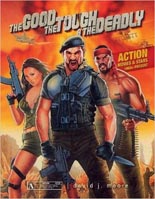 More creatively satisfying than World Gone Wild, his 2014 survey of postapocalyptic films, David J. Moore’s The Good, the Tough & the Deadly: Action Movies & Stars 1960s-Present is in reach of claiming definitive status, but falls short in its deliberate choice (too convoluted to discuss here) to exclude the genre’s seminal titles from coverage. Die Hard? Not here. Escape from New York? Not here. Lethal Weapon? Not here. Excessive Force II: Force on Force? Totally here! In essence, the 5-pound hardcover is built mostly upon the VHSographies of such lower-rung stars as Michael Dudikoff, Mark Dacascos, Oliver Gruner, Billy Blanks and Don “The Dragon” Wilson, and there’s absolutely not a damn thing wrong with that obscurities-first approach. Prepare to find yourself spending hours falling down the rabbit hole of looking up one flick, which only reminds you of three to four others, thereby decimating any intent to consume its contents in an orderly fashion. Supplementing around 500 pages of reviews (with Destroy All Movies’ Zack Carlson and Seagalogy’s Vern occasionally weighing in) are here-and-there, unedited transcripts of Q-and-As with personalities like Dolph Lundgren and Cynthia Rothrock. These would be more welcome if Moore’s interview style were less ass-kissing, had fewer yes/no questions and contained absolutely no statements along the lines of “Say something about [insert title here].” Mitigating factor: Heavily illustrated in full color throughout.
More creatively satisfying than World Gone Wild, his 2014 survey of postapocalyptic films, David J. Moore’s The Good, the Tough & the Deadly: Action Movies & Stars 1960s-Present is in reach of claiming definitive status, but falls short in its deliberate choice (too convoluted to discuss here) to exclude the genre’s seminal titles from coverage. Die Hard? Not here. Escape from New York? Not here. Lethal Weapon? Not here. Excessive Force II: Force on Force? Totally here! In essence, the 5-pound hardcover is built mostly upon the VHSographies of such lower-rung stars as Michael Dudikoff, Mark Dacascos, Oliver Gruner, Billy Blanks and Don “The Dragon” Wilson, and there’s absolutely not a damn thing wrong with that obscurities-first approach. Prepare to find yourself spending hours falling down the rabbit hole of looking up one flick, which only reminds you of three to four others, thereby decimating any intent to consume its contents in an orderly fashion. Supplementing around 500 pages of reviews (with Destroy All Movies’ Zack Carlson and Seagalogy’s Vern occasionally weighing in) are here-and-there, unedited transcripts of Q-and-As with personalities like Dolph Lundgren and Cynthia Rothrock. These would be more welcome if Moore’s interview style were less ass-kissing, had fewer yes/no questions and contained absolutely no statements along the lines of “Say something about [insert title here].” Mitigating factor: Heavily illustrated in full color throughout.
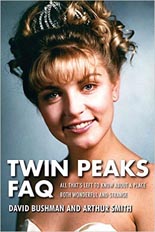 If you want to prep for next year’s Twin Peaks relaunch with a recent text on the cult series, buy Brad Dukes’ oral history, Reflections. If you buy two, get that and Twin Peaks FAQ: All That’s Left to Know About a Place Both Wonderful and Strange. In this entry of Applause’s pop-culture FAQ line, David Bushman and Arthur Smith cover the David Lynch/Mark Frost cult classic with a crash course that qualifies both as entry-level and deep-dive. The co-authors are at their best in the general, behind-the-scenes stories of how the groundbreaking series and its misunderstood movie prequel came to pass and how the television was changed forever after. Of almost as much interest are chapters detailing the various tie-in books, copycat TV series and cultural references, but the more obsessive the sections get (such as laying out the entire mystery’s events in a timeline), the less I was interested. Unlike the aforementioned Reflections, this FAQ is nonessential for Peaks freaks (or those destined to be), but it certainly doesn’t hurt, either.
If you want to prep for next year’s Twin Peaks relaunch with a recent text on the cult series, buy Brad Dukes’ oral history, Reflections. If you buy two, get that and Twin Peaks FAQ: All That’s Left to Know About a Place Both Wonderful and Strange. In this entry of Applause’s pop-culture FAQ line, David Bushman and Arthur Smith cover the David Lynch/Mark Frost cult classic with a crash course that qualifies both as entry-level and deep-dive. The co-authors are at their best in the general, behind-the-scenes stories of how the groundbreaking series and its misunderstood movie prequel came to pass and how the television was changed forever after. Of almost as much interest are chapters detailing the various tie-in books, copycat TV series and cultural references, but the more obsessive the sections get (such as laying out the entire mystery’s events in a timeline), the less I was interested. Unlike the aforementioned Reflections, this FAQ is nonessential for Peaks freaks (or those destined to be), but it certainly doesn’t hurt, either.
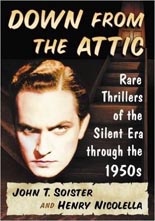 A follow-up to their Up from the Vaults volume of 2004, John T. Soister and Henry Nicolella’s Down from the Attic: Rare Thrillers of the Silent Era Through the 1950s excavates two dozen films that truly meet the “rare” criteria and presents more information on them than we’re likely to get anywhere else. Among those covered: a lost Charlie Chan mystery, 1926’s The House Without a Key; an Edgar Wallace feature in 1934’s Return of the Terror; and 1921’s Island of the Lost, an unofficial adaptation of H.G. Wells’ Dr. Moreau that predates the official one. The label they place upon 1937 Sherlock Holmes entry, Der Hund von Baskerville, could apply to all of their subjects: “more of a curiosity than a classic.” Soister and Nicolella are the first to admit that “no great movies [are] in the bunch,” but they approach each picture as if it were, with amazingly thorough research and critical review. Synopses can — and do — grow tiring, but given the obscurity of these thrillers, the authors can be forgiven on the basis of historical preservation. Like so many of McFarland & Company’s film books, the wealth of stills and poster art is most appreciated, especially in the case of the mesmerizing Just Imagine, a forward-thinker from 1930.
A follow-up to their Up from the Vaults volume of 2004, John T. Soister and Henry Nicolella’s Down from the Attic: Rare Thrillers of the Silent Era Through the 1950s excavates two dozen films that truly meet the “rare” criteria and presents more information on them than we’re likely to get anywhere else. Among those covered: a lost Charlie Chan mystery, 1926’s The House Without a Key; an Edgar Wallace feature in 1934’s Return of the Terror; and 1921’s Island of the Lost, an unofficial adaptation of H.G. Wells’ Dr. Moreau that predates the official one. The label they place upon 1937 Sherlock Holmes entry, Der Hund von Baskerville, could apply to all of their subjects: “more of a curiosity than a classic.” Soister and Nicolella are the first to admit that “no great movies [are] in the bunch,” but they approach each picture as if it were, with amazingly thorough research and critical review. Synopses can — and do — grow tiring, but given the obscurity of these thrillers, the authors can be forgiven on the basis of historical preservation. Like so many of McFarland & Company’s film books, the wealth of stills and poster art is most appreciated, especially in the case of the mesmerizing Just Imagine, a forward-thinker from 1930.
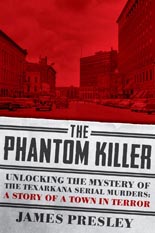 Two things steered me toward wanting to read James Presley’s The Phantom Killer: Unlocking the Mystery of the Texarkana Serial Murders: The Story of a Town in Terror: First was the unexpectedly clever reboot of The Town That Dreaded Sundown, which depicted the still officially unsolved crime spree. Second was the segment on said subject in the documentary Killer Legends, which utilizes Presley as a talking-head expert. I’m glad something did, because the book — now in paperback from Pegasus Crime — is deserving of status as a true-crime masterpiece à la Vincent Bugliosi’s Helter Skelter, in part because, as with that 1974 classic, it chilled me to the core in the middle of a sunny afternoon. Combining an investigative reporter’s doggedness with a storyteller’s skillful hooks, Presley gets under your skin and stays there long after you’ve hit the last page.
Two things steered me toward wanting to read James Presley’s The Phantom Killer: Unlocking the Mystery of the Texarkana Serial Murders: The Story of a Town in Terror: First was the unexpectedly clever reboot of The Town That Dreaded Sundown, which depicted the still officially unsolved crime spree. Second was the segment on said subject in the documentary Killer Legends, which utilizes Presley as a talking-head expert. I’m glad something did, because the book — now in paperback from Pegasus Crime — is deserving of status as a true-crime masterpiece à la Vincent Bugliosi’s Helter Skelter, in part because, as with that 1974 classic, it chilled me to the core in the middle of a sunny afternoon. Combining an investigative reporter’s doggedness with a storyteller’s skillful hooks, Presley gets under your skin and stays there long after you’ve hit the last page.
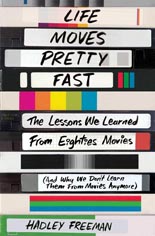 In 11 sharp and witty essays, each focused on a particular film, Hadley Freeman takes a long look back at the countless hours spent with Ferris Bueller, Andie Walsh and Marty McFly — and what we collectively gleaned from their return visits — in Life Moves Pretty Fast: The Lessons We Learned from Eighties Movies (And Why We Don’t Learn Them from Movies Anymore). Front-loaded with “chick flicks” like Dirty Dancing and The Princess Bride, the book widens appeal as it goes, looping in Batman, Ghostbusters and peak Eddie Murphy as Hadley celebrates these pictures by breaking down their simple pleasures and more complicated subtext. She praises the era’s comedies for being “willing to deal” with issues of social class (thanks, John Hughes), while also damning them for having their female characters “dress like shit” (thanks, John Hughes). Despite the author’s overuse/misuse of “literally” and transitory lists whose punch lines fail to pop, Life Moves Pretty Fast is a smart, no-brainer buy full of laughs, love and longing. —Rod Lott
In 11 sharp and witty essays, each focused on a particular film, Hadley Freeman takes a long look back at the countless hours spent with Ferris Bueller, Andie Walsh and Marty McFly — and what we collectively gleaned from their return visits — in Life Moves Pretty Fast: The Lessons We Learned from Eighties Movies (And Why We Don’t Learn Them from Movies Anymore). Front-loaded with “chick flicks” like Dirty Dancing and The Princess Bride, the book widens appeal as it goes, looping in Batman, Ghostbusters and peak Eddie Murphy as Hadley celebrates these pictures by breaking down their simple pleasures and more complicated subtext. She praises the era’s comedies for being “willing to deal” with issues of social class (thanks, John Hughes), while also damning them for having their female characters “dress like shit” (thanks, John Hughes). Despite the author’s overuse/misuse of “literally” and transitory lists whose punch lines fail to pop, Life Moves Pretty Fast is a smart, no-brainer buy full of laughs, love and longing. —Rod Lott
